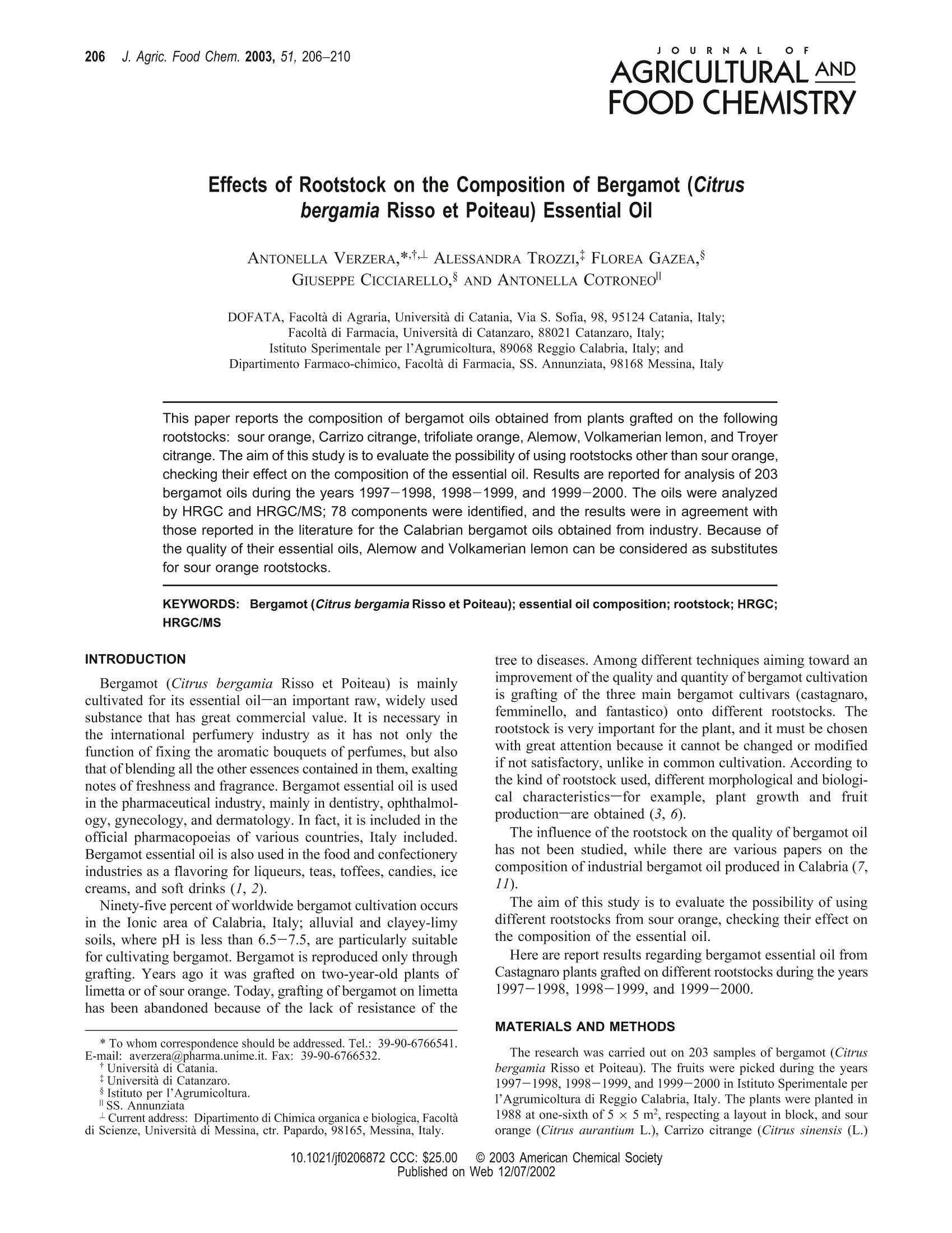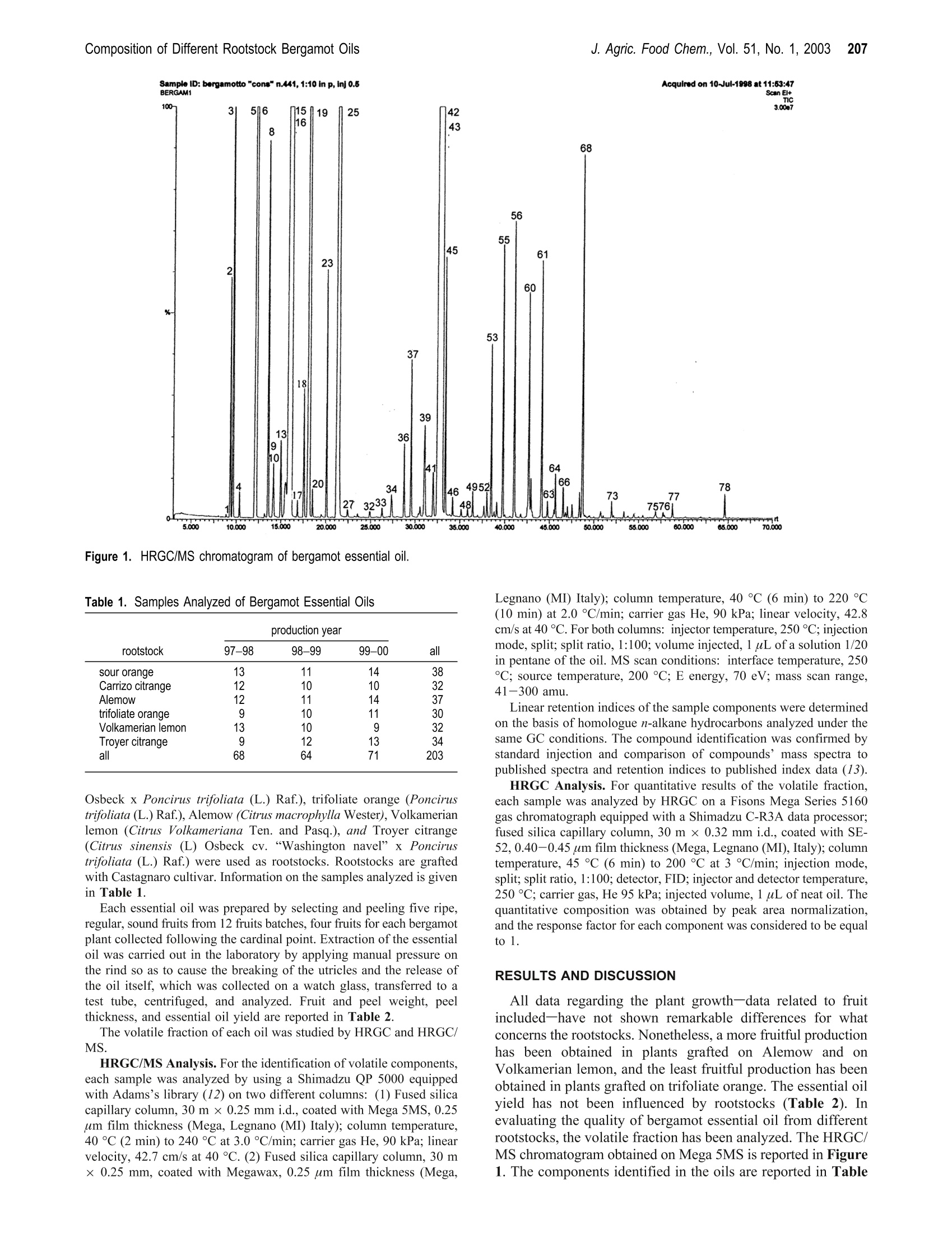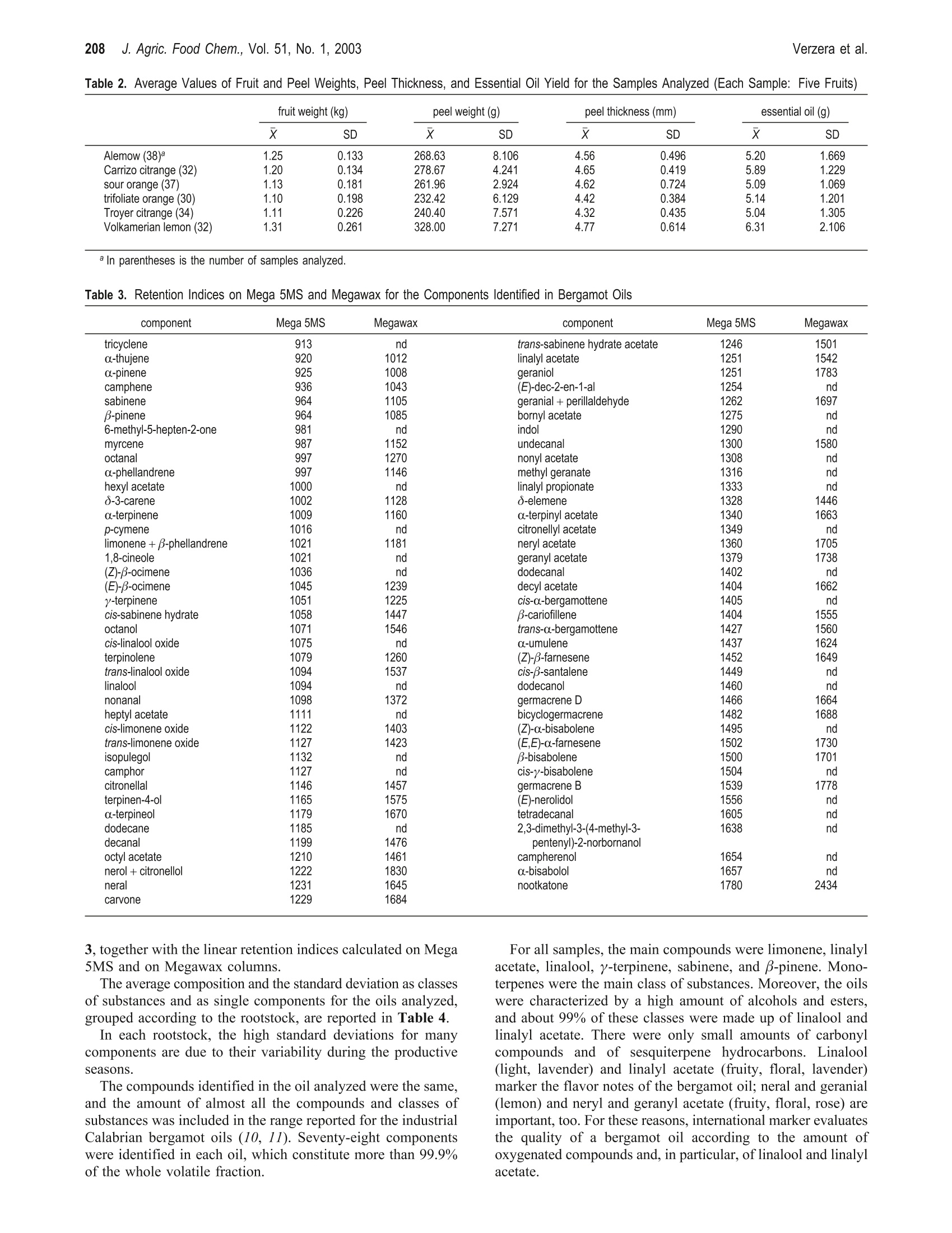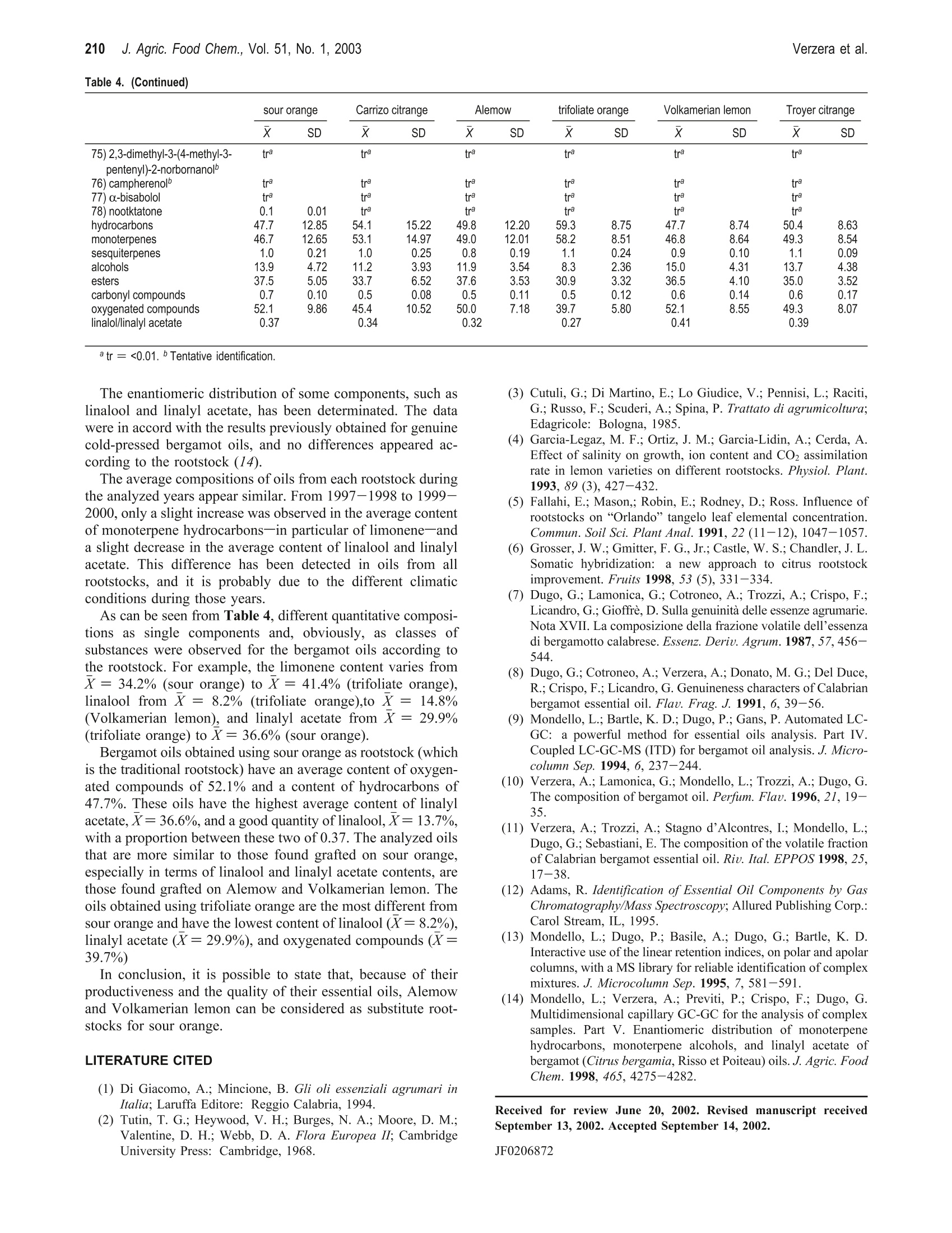
方案详情
文
Bergamot (Citrus bergamia Risso et Poiteau) is mainly cultivated for its essential oilsan important raw, widely used substance that has great commercial value....
方案详情

J OURRNNAA L FAGRICULTURALANDFOOD CHEMISTRYJ. Agric. Food Chem. 2003, 51, 206-210206 Composition of Different Rootstock Bergamot OilsJ. Agric. Food Chem., Vol. 51, No. 1, 2003207Acquired on 10-Jul-1998 at 11:53:47Scan El+ Effects of Rootstock on the Composition of Bergamot (Citrusbergamia Risso et Poiteau) Essential Oil ANTONELLA VERZERA,*,T, ALESSANDRA TROZZI.+ FLOREA GAZEA,SGIUSEPPE CICCIARELLO,S AND ANTONELLA COTRONEO" DOFATA, Facolta di Agraria, Universita di Catania, Via S. Sofia, 98, 95124 Catania, Italy; Facolta di Farmacia, Universita di Catanzaro, 88021 Catanzaro, Italy; Istituto Sperimentale per l'Agrumicoltura, 89068 Reggio Calabria, Italy; and Dipartimento Farmaco-chimico, Facolta di Farmacia, SS. Annunziata, 98168 Messina, Italy This paper reports the composition of bergamot oils obtained from plants grafted on the followingrootstocks: sour orange, Carrizo citrange,trifoliate orange, Alemow, Volkamerian lemon, and Troyercitrange. The aim of this study is to evaluate the possibility of using rootstocks other than sour orange,checking their effect on the composition of the essential oil. Results are reported for analysis of 203bergamot oils during the years 1997-1998, 1998-1999, and 1999-2000. The oils were analyzedby HRGC and HRGC/MS; 78 components were identified, and the results were in agreement withthose reported in the literature for the Calabrian bergamot oils obtained from industry. Because ofthe quality of their essential oils, Alemow and Volkamerian lemon can be considered as substitutesfor sour orange rootstocks. KEYWORDS: EBergamot (Citrus bergamia Risso et Poiteau); essential oil composition; rootstock; HRGC;HRGC/MS INTRODUCTION Bergamot (Citrus bergamia Risso et Poiteau) is mainlycultivated for its essential oil-an important raw, widely usedsubstance that has great commercial value. It is necessary inthe international perfumery industry as it has not only thefunction of fixing the aromatic bouquets of perfumes, but alsothat of blending all the other essences contained in them, exaltingnotes of freshness and fragrance. Bergamot essential oil is usedin the pharmaceutical industry, mainly in dentistry, ophthalmol-ogy, gynecology, and dermatology. In fact, it is included in theofficial pharmacopoeias of various countries, Italy included.Bergamot essential oil is also used in the food and confectioneryindustries as a flavoring for liqueurs, teas, toffees, candies, icecreams, and soft drinks (1, 2). Ninety-five percent of worldwide bergamot cultivation occursin the Ionic area of Calabria, Italy; alluvial and clayey-limysoils, where pH is less than 6.5-7.5, are particularly suitablefor cultivating bergamot. Bergamot is reproduced only throughgrafting. Years ago it was grafted on two-year-old plants oflimetta or of sour orange. Today, grafting of bergamot on limettahas been abandoned because of the lack of resistance of the ( * T o w hom correspondence should be addressed. Te l .: 39 - 90-6766541.E-mail: averzera@pharma.unime.it. Fax: 3 9- 9 0-6766532. ) ( Universita di Catania. ) ( U niversita di Catanzaro. ) ( Istituto per IAgrumicoltura. ) ( " SS. Annunziata ) ( -Current address: D ipartimento di Chimica organica e biologica, Facoltadi Scienze, U niversita di M essina, c t r. Papardo, 98165, Messina, Ita l y. ) tree to diseases. Among different techniques aiming toward animprovement of the quality and quantity of bergamot cultivationis grafting of the three main bergamot cultivars (castagnaro,femminello, and fantastico) onto different rootstocks. Therootstock is very important for the plant, and it must be chosenwith great attention because it cannot be changed or modifiedif not satisfactory, unlike in common cultivation. According tothe kind of rootstock used, different morphological and biologi-cal characteristics-for example, plant growth and fruitproduction-are obtained (3,6). The influence of the rootstock on the quality of bergamot oilhas not been studied, while there are various papers on thecomposition of industrial bergamot oil produced in Calabria (7,11). The aim of this study is to evaluate the possibility of usingdifferent rootstocks from sour orange, checking their effect onthe composition of the essential oil. Here are report results regarding bergamot essential oil fromCastagnaro plants grafted on different rootstocks during the years1997-1998,1998-1999, and 1999-2000. MATERIALS AND METHODS The research was carried out on 203 samples of bergamot (Citrusbergamia Risso et Poiteau). The fruits were picked during the years1997-1998,1998-1999, and 1999-2000 in Istituto Sperimentale perIAgrumicoltura di Reggio Calabria, Italy. The plants were planted in1988 at one-sixth of 5 × 5 m², respecting a layout in block, and sourorange (Citrus aurantium L.), Carrizo citrange (Citrus sinensis (L.) Sample ID: bergamotto "cons" n.441, 1:10 in p, inj 0.5 Figure 1. HRGC/MS chromatogram of bergamot essential oil. Table 1. Samples Analyzed of Bergamot Essential Oils production year rootstock 97-98 98-99 99-00 all sour orange Carrizo citrange Alemow trifoliate orange Volkamerian lemon 13 Troyer citrange all Osbeck x Poncirus trifoliata (L.) Raf.), trifoliate orange (Poncirustrifoliata (L.)Raf.), Alemow (Citrus macrophylla Wester), Volkamerianlemon (Citrus Volkameriana Ten. and Pasq.), and Troyer citrange(Citrus sinensis (L) Osbeck cv.“Washington navel” x Poncirustrifoliata (L.) Raf.) were used as rootstocks. Rootstocks are graftedwith Castagnaro cultivar. Information on the samples analyzed is givenin Table 1. Each essential oil was prepared by selecting and peeling five ripe,regular, sound fruits from 12 fruits batches, four fruits for each bergamotplant collected following the cardinal point. Extraction of the essentialoil was carried out in the laboratory by applying manual pressure onthe rind so as to cause the breaking of the utricles and the release ofthe oil itself, which was collected on a watch glass, transferred to atest tube, centrifuged, and analyzed. Fruit and peel weight, peelthickness, and essential oil yield are reported in Table 2. The volatile fraction of each oil was studied by HRGC and HRGC/MS. HRGC/MS Analysis. For the identification of volatile components,each sample was analyzed by using a Shimadzu QP 5000 equippedwith Adams’s library (12) on two different columns: (1) Fused silicacapillary column, 30 m x 0.25 mm i.d.,coated with Mega 5MS, 0.25um film thickness (Mega, Legnano (MI) Italy); column temperature,40℃ (2 min) to 240C at 3.0 C/min; carrier gas He, 90 kPa; linearvelocity, 42.7 cm/s at 40 C. (2) Fused silica capillary column, 30 mx 0.25 mm, coated with Megawax, 0.25 um film thickness (Mega, Legnano (MI) Italy); column temperature, 40℃ (6 min) to 220 °C(10 min) at 2.0°C/min; carrier gas He, 90 kPa; linear velocity, 42.8cm/s at 40 °C. For both columns: injector temperature, 250°C; injectionmode, split; split ratio, 1:100; volume injected, 1 uL of a solution 1/20in pentane of the oil. MS scan conditions: interface temperature, 250°C; source temperature, 200℃; E energy, 70 eV; mass scan range,41-300 amu. Linear retention indices of the sample components were determinedon the basis of homologue n-alkane hydrocarbons analyzed under thesame GC conditions. The compound identification was confirmed bystandard injection and comparison of compounds’ mass spectra topublished spectra and retention indices to published index data (13). HRGC Analysis. For quantitative results of the volatile fraction,each sample was analyzed by HRGC on a Fisons Mega Series 5160gas chromatograph equipped with a Shimadzu C-R3A data processor;fused silica capillary column, 30 m x 0.32 mm i.d., coated with SE-52, 0.40-0.45 um film thickness (Mega, Legnano (MI), Italy); columntemperature, 45 ℃ (6 min) to 200 ℃ at 3 °C/min; injection mode,split; split ratio, 1:100; detector, FID; injector and detector temperature,250°C; carrier gas, He 95 kPa; injected volume, 1 uL of neat oil. Thequantitative composition was obtained by peak area normalization,and the response factor for each component was considered to be equalto 1. RESULTS AND DISCUSSION All data regarding the plant growth-data related to fruitincluded-have not shown remarkable differences for whatconcerns the rootstocks. Nonetheless, a more fruitful productionhas been obtained in plants grafted on Alemow and onVolkamerian lemon, and the least fruitful production has beenobtained in plants grafted on trifoliate orange. The essential oilyield has not been influenced by rootstocks (Table 2). Inevaluating the quality of bergamot essential oil from differentrootstocks, the volatile fraction has been analyzed. The HRGC/MS chromatogram obtained on Mega 5MS is reported in Figure1. The components identified in the oils are reported in Table Table 2. Average Values of Fruit and Peel Weights, Peel Thickness, and Essential Oil Yield for the Samples Analyzed (Each Sample: Five Fruits) fruit weight (kg) peel weight (g) peel thickness (mm) essential oil (g) X SD X SD X SD X SD Alemow (38)a 1.25 0.133 268.63 8.106 4.56 0.496 5.20 1.669 Carrizo citrange (32) 1.20 0.134 278.67 4.241 4.65 0.419 5.89 1.229 sour orange (37) 1.13 0.181 261.96 2.924 4.62 0.724 5.09 1.069 trifoliate orange (30) 1.10 0.198 232.42 6.129 4.42 0.384 5.14 1.201 Troyer citrange (34) 1.11 0.226 240.40 7.571 4.32 0.435 5.04 1.305 Volkamerian lemon (32) 1.31 0.261 328.00 7.271 4.77 0.614 6.31 2.106 a In parentheses is the number of samples analyzed. Table 3. Retention Indices on Mega 5MS and Megawax for the Components Identified in Bergamot Oils 3,together with the linear retention indices calculated on Mega5MS and on Megawax columns. The average composition and the standard deviation as classesof substances and as single components for the oils analyzed,grouped according to the rootstock, are reported in Table 4. In each rootstock, the high standard deviations for manycomponents are due to their variability during the productiveseasons. The compounds identified in the oil analyzed were the same,and the amount of almost all the compounds and classes ofsubstances was included in the range reported for the industrialCalabrian bergamot oils (10,11). Seventy-eight componentswere identified in each oil, which constitute more than 99.9%of the whole volatile fraction. For all samples, the main compounds were limonene, linalylacetate, linalool, y-terpinene, sabinene, and B-pinene. Mono-terpenes were the main class of substances. Moreover, the oilswere characterized by a high amount of alcohols and esters,and about 99% of these classes were made up of linalool andlinalyl acetate. There were only small amounts of carbonylcompounds and of sesquiterpene hydrocarbons. Linalool(light, lavender) and linalyl acetate (fruity, floral, lavender)marker the flavor notes of the bergamot oil; neral and geranial(lemon) and neryl and geranyl acetate (fruity, floral,rose) areimportant, too. For these reasons, international marker evaluatesthe quality of a bergamot oil according to the amount ofoxygenated compounds and, in particular, of linalool and linalylacetate. o a 3 0.03 汽 00 0.0.:28 0导导:导1 4 o X1 a IX o 8 : o X8898宝品X1 : coo二 co一 c一 >o : 5 38 ce O w co一 c' 寸cc 一c a o二 cc 一co心 ccoc一 : oc :8 一cc 88 cc' co 位 co 二 wccacco E coc'一 388 x 一ccwwca' co一6 : cE 28 co'cE 8 cca ca 88883 cc 888 IX 1X IX X o 一 coc 一c 云w aa Table 4. (Continued) sour orange Carrizo citrange Alemow trifoliate orange Volkamerian lemon Troyer citrange SD X SD X SD X SD X SD X SD 75)2,3-dimethyl-3-(4-methyl-3- tra tra tra tra tra tra pentenyl)-2-norbornanolP 76) campherenol tra tra tra tra tra tra 77)a-bisabolol tra tra tra tra tra tra 78) nootktatone 0.1 0.01 tra tra tra tra tra hydrocarbons 47.7 12.85 54.1 15.22 49.8 12.20 59.3 8.75 47.7 8.74 50.4 8.63 monoterpenes 46.7 12.65 53.1 14.97 49.0 12.01 58.2 8.51 46.8 8.64 49.3 8.54 sesquiterpenes 1.0 0.21 1.0 0.25 0.8 0.19 1.1 0.24 0.9 0.10 1.1 0.09 alcohols 13.9 4.72 11.2 3.93 11.9 3.54 8.3 2.36 15.0 4.31 13.7 4.38 esters 37.5 5.05 33.7 6.52 37.6 3.53 30.9 3.32 36.5 4.10 35.0 3.52 carbonyl compounds 0.7 0.10 0.5 0.08 0.5 0.11 0.5 0.12 0.6 0.14 0.6 0.17 oxygenated compounds 52.1 9.86 45.4 10.52 50.0 7.18 39.7 5.80 52.1 8.55 49.3 8.07 linalol/linalyl acetate 0.37 0.34 0.32 0.27 0.41 0.39 The enantiomeric distribution of some components, such aslinalool and linalyl acetate, has been determinated. The datawere in accord with the results previously obtained for genuinecold-pressed bergamot oils, and no differences appeared ac-cording to the rootstock (14). The average compositions of oils from each rootstock duringthe analyzed years appear similar. From 1997-1998 to 1999-2000, only a slight increase was observed in the average contentof monoterpene hydrocarbons-in particular of limonene-anda slight decrease in the average content of linalool and linalylacetate. This difference has been detected in oils from allrootstocks, and it is probably due to the different climaticconditions during those years. As can be seen from Table 4, different quantitative composi-tions as single components and, obviously, as classes ofsubstances were observed for the bergamot oils according tothe rootstock. For example, the limonene content varies fromX=34.2% (sour orange) to X =41.4% (trifoliate orange),linalool from X= 8.2% (trifoliate orange),to X= 14.8%(Volkamerriiaann lemon), and linalyl acetate from X=29.9%(9)(trifoliate orange) toX=36.6% (sour orange). Bergamot oils obtained using sour orange as rootstock (whichis the traditional rootstock) have an average content of oxygen-ated compounds of 52.1% and a content of hydrocarbons of47.7%. These oils have the highest average content of linalylacetate, X =36.6%, and a good quantity of linalool, X=13.7%,with a proportion between these two of 0.37. The analyzed oilsthat are more similar to those found grafted on sour orange,especially in terms of linalool and linalyl acetate contents, arethose found grafted on Alemow and Volkamerian lemon. Theoils obtained using trifoliate orange are the most different fromsour orange and have the lowest content of linalool (X=8.2%),linalyl acetate (X=29.9%), and oxygenated compounds (X=39.7%) In conclusion, it is possible to state that, because of theirproductiveness and the quality of their essential oils, Alemowand Volkamerian lemon can be considered as substitute root-stocks for sour orange. LITERATURE CITED (1) Di Giacomo, A.; Mincione, B. Gli oli essenziali agrumari inItalia;Laruffa Editore: Reggio Calabria, 1994. (2)Tutin, T. G.; Heywood, V. H.; Burges, N. A.; Moore, D. M.;Valentine, D. H.; Webb, D. A. Flora Europea II; CambridgeUniversity Press: Cambridge, 1968. ( (3) C utuli, G.; Di M artino, E.;Lo Giudice, V.; Pennisi, L. ; Raciti,G.; Russo, F.; S cuderi, A.; Spina, P . Trattato di agrumicoltura; E dagricole: Bologna, 1 985. ) (4) G(arcia-Legaz, M. F.; Ortiz, J. M.; Garcia-Lidin, A.; Cerda, A.Effect of salinity on growth, ion content and CO2 assimilationrate in lemon varieties on different rootstocks. Physiol. Plant.1993, 89 (3), 427-432. (5) Fallahi, E.;Mason,; Robin, E.; Rodney, D.; Ross. Influence ofrootstocks on“Orlando” tangelo leaf elemental concentration.Commun. Soil Sci. Plant Anal. 1991, 22 (11-12), 1047-1057. (6) Grosser, J. W.; Gmitter, F. G., Jr.; Castle, W.S.; Chandler, J. L.Somatic hybridization: a new approach to citrus rootstockimprovement. Fruits 1998,53 (5), 331-334. (7) Dugo, G.; Lamonica, G.; Cotroneo, A.; Trozzi, A.; Crispo, F.;Licandro, G.; Gioffre,D. Sulla genuinita delle essenze agrumarie.Nota XVI. La composizione della frazione volatile dell'essenzadibergamotto calabrese. Essenz. Deriv. Agrum. 1987, 57, 456-544. ( (8) Dugo, G.; Cotroneo, A .; Verzera, A.; Donato, M. G .; Del D uce, R .; Crispo,F.; L i c andro, G. Genuineness characters of Calabrian bergamot essential o il. Flav. Frag. J. 1991, 6, 39-56. ) (9) Mondello, L.; Bartle, K. D.; Dugo, P.; Gans, P. Automated LC-GC: a powerful method for essential oils analysis. Part IV.Coupled LC-GC-MS (ITD) for bergamot oil analysis. J. Micro-column Sep. 1994, 6,237-244. (10) Verzera, A.; Lamonica, G.; Mondello, L.; Trozzi, A.; Dugo, G.The composition of bergamot oil. Perfum. Flav. 1996, 21, 19-35. (11) Verzera, A.; Trozzi, A.; Stagno d'Alcontres, I.; Mondello, L.;Dugo, G.; Sebastiani, E. The composition of the volatile fractionof Calabrian bergamot essential oil. Riv. Ital. EPPOS 1998, 25,17-38. (12) Adams, R. Identification of Essential Oil Components by GasChromatography/Mass Spectroscopy; Allured Publishing Corp.:Carol Stream, IL, 1995. (13) Mondello, L.; Dugo, P.; Basile, A.; Dugo, G.;Bartle, K. D.Interactive use of the linear retention indices, on polar and apolarcolumns, with a MS library for reliable identification ofcomplexmixtures. J. Microcolumn Sep. 1995, 7, 581-591. (14) Mondello, L.; Verzera, A.; Previti, P.; Crispo, F.; Dugo, G.Multidimensional capillary GC-GC for the analysis of complexsamples. Part V. Enantiomeric distribution of monoterpenehydrocarbons, monoterpene alcohols, and linalyl acetate ofbergamot (Citrus bergamia, Risso et Poiteau) oils. J. Agric. FoodChem. 1998,465,4275-4282. ( Received f or r eview June 2 0 , 2 0 02. Revised ma n uscript rec e ivedSeptember 13, 2002. Accepted September 14,2002. ) jfCCC: $ American Chemical SocietyPublished on Web JF
确定





还剩3页未读,是否继续阅读?
华明科技(香港)有限公司为您提供《佛手柑精油中成分分析检测方案 》,该方案主要用于日用化学品/香精香料中成分分析检测,参考标准--,《佛手柑精油中成分分析检测方案 》用到的仪器有
相关方案
更多







